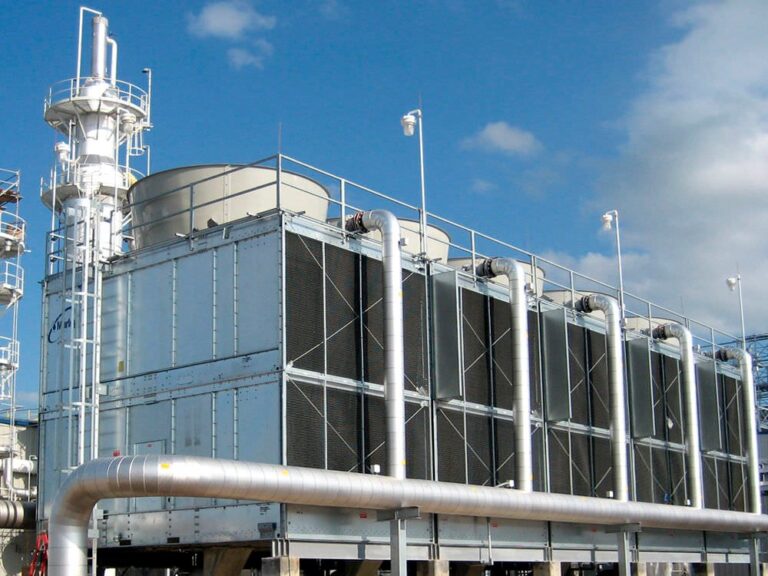Introduction
Biocide-Free Cooling is emerging as a revolutionary approach to water treatment in industrial cooling towers, offering an environmentally friendly alternative to traditional chemical biocides. By leveraging advanced technologies like UV disinfection, ozone treatment, and ultrasonic waves, this method eliminates harmful microorganisms without relying on toxic chemicals. This not only reduces the environmental impact but also promotes safer water management practices, aligning with the growing demand for sustainable industrial solutions.
Innovations in Biocide-Free Cooling
Ultraviolet (UV) Disinfection
- Overview: UV light systems are used to disinfect water by destroying the DNA of microorganisms, preventing their growth and reproduction. UV treatment is chemical-free, leaves no residues, and is highly effective in controlling bacteria and algae in cooling water.
- Benefits: No harmful chemicals, minimal maintenance, and safe for the environment.
Ozone Treatment
- Overview: Ozone, a powerful oxidizer, is injected into cooling water to eliminate bacteria, algae, and other microorganisms. Ozone rapidly breaks down after disinfection, leaving no chemical residues. It also helps in reducing scaling and fouling in the system.
- Benefits: High disinfection efficiency, reduced chemical use, and improved system cleanliness.
Electrolytic Water Treatment
- Overview: This technology uses electrochemical processes to produce ions that inhibit microbial growth and prevent scale formation. The system works by passing a small electric current through the water, generating ions that attack microorganisms.
- Benefits: No added chemicals, lower operational costs, and effective against biofilm and scaling.
Copper-Silver Ionization
- Overview: Copper-silver ionization systems release copper and silver ions into the water, which are toxic to bacteria, algae, and viruses. This method is commonly used in hospital water systems to control Legionella and other harmful microorganisms.
- Benefits: Long-lasting protection, non-corrosive, and safe for the environment.
Ultrasonic Treatment
- Overview: Ultrasonic devices generate high-frequency sound waves that disrupt the cellular structure of microorganisms, preventing them from reproducing. This non-chemical approach is effective in reducing biofouling and maintaining clean water in cooling towers.
- Benefits: Chemical-free, energy-efficient, and reduces biofilm formation.
Hydrocyclonic Separation
- Overview: This mechanical filtration technology uses centrifugal force to separate suspended solids and microorganisms from cooling water. By removing contaminants, hydrocyclonic separation reduces the need for biocides and improves system efficiency.
- Benefits: No chemicals, reduced maintenance, and enhanced water quality.
Benefits of Biocide-Free Cooling
Environmental Safety
- Overview: By eliminating harmful chemical biocides, these alternative treatments reduce the risk of environmental contamination and promote safer discharge of water into natural ecosystems.
- Impact: Aligns with sustainable practices and reduces the overall environmental impact of industrial cooling operations.
Reduced Chemical Costs
- Overview: Biocide-free systems lower or eliminate the need for purchasing, storing, and handling chemical biocides, leading to cost savings in the long term.
- Impact: Operational cost reduction and simplified regulatory compliance.
Enhanced Safety for Workers
- Overview: Without the need for handling toxic chemicals, the risk of exposure and associated health hazards for workers is significantly reduced.
- Impact: Improved workplace safety and fewer occupational health concerns.
Prevention of Resistant Microorganisms
- Overview: The use of non-chemical methods reduces the risk of microorganisms developing resistance to treatment, which is a growing concern with traditional biocides.
- Impact: Long-term effectiveness of microbial control strategies.
Challenges and Considerations
Initial Investment
- Overview: While biocide-free systems offer long-term cost savings, the initial investment in advanced technologies like UV systems or ionization can be higher than traditional chemical treatments.
- Consideration: Industries must evaluate the return on investment based on operational savings and environmental benefits.
System Compatibility
- Overview: Not all biocide-free technologies are suitable for every cooling tower system, depending on factors like system size, water quality, and cooling load.
- Consideration: Proper assessment and customization are necessary to ensure optimal performance.
Ongoing Maintenance
- Overview: While biocide-free systems reduce chemical use, they still require regular maintenance and monitoring to ensure consistent performance.
- Consideration: Adequate maintenance protocols should be established to maximize the lifespan and efficiency of the system.
Conclusion
Biocide-free cooling technologies represent a significant advancement in environmentally friendly water treatment for industrial cooling towers. By eliminating the need for harmful chemicals, these innovative systems help industries reduce their environmental footprint, enhance operational safety, and maintain compliance with increasingly stringent regulations. As companies continue to prioritize sustainability, biocide-free cooling solutions will play a crucial role in the future of industrial cooling.

